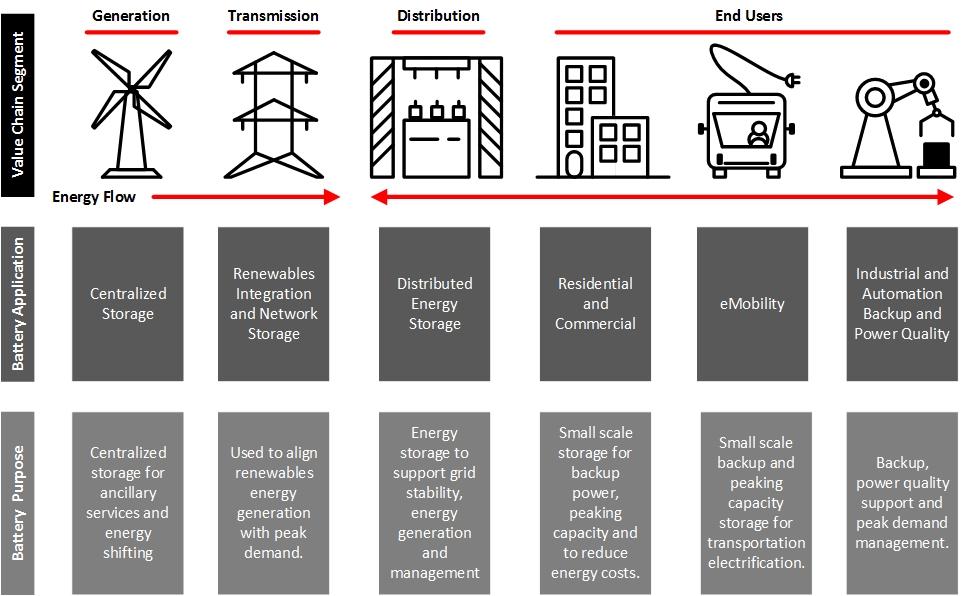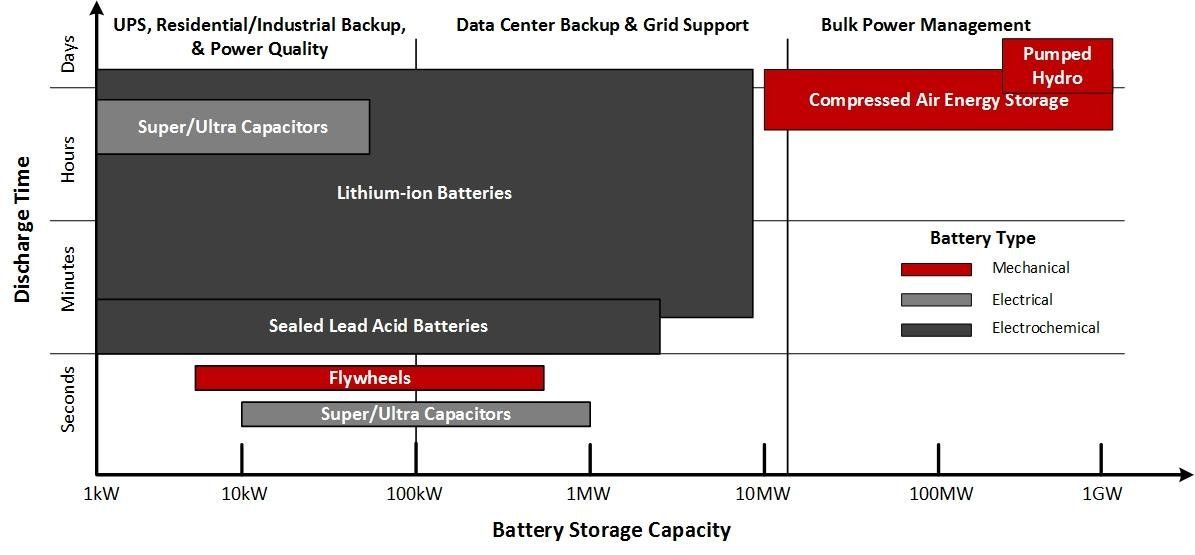Battery Energy Storage Systems Introduction
Glossary of Terms
Backup power, following a catastrophic failure of the grid, batteries provide an active reserve of power and energy that can energize transmission and distribution lines, provide start-up power for generators, or provide a reference frequency.
Decarbonization is the reduction of carbon dioxide emissions and greenhouse gasses into the atmosphere through the use of low carbon power sources.
Load leveling/management provides a demand-side customer-related service. Load management services include managing power quality, power reliability (grid-connected or microgrid operation), retail electrical energy time-shift, demand charge management, and renewable power consumption maximization, which refers to charging the battery storage system during periods when renewable energy is greatest to consume the maximum renewable energy from the battery system, or in other words, charging with solar during the day and charging with wind during high wind periods or at night.
Peaking capacity is the battery capacity available to support the highest amount of energy that an end user pulls from the grid in a set period of time.
Peak shaving is the leveling out of peaks in electricity use by charging batteries when the rates are low and discharging them when the electricity rates are high.
Sub-transmission voltages are grid distribution line voltages from 4kV - 69kV.
Supercapacitor/Ultracapacitor is a high-capacity capacitor with a capacitance value much higher than other capacitors, but with lower voltage limits, that bridges the gap between electrolytic capacitors and rechargeable batteries. (1
Transmission voltages are grid transmission line voltages from 138kV - 765kV.
1) https://en.wikipedia.org/wiki/Supercapacitor
Overview
In order to have a clear picture of battery energy storage products and services provided by industry vendors, one must have a basic understanding of the role of batteries in a battery energy storage system. They are used for storing energy that powers other electronic and/or electromechanical components to generate electricity. These components are used with batteries to create a complete battery energy storage system, which can be deployed throughout the Electricity Value Chain.
Goal
Sol Donum™ designs and manufactures turnkey battery energy storage system products. This document provides an introductory summarization of battery energy storage systems and how they support the Electricity Value Chain (‘the grid’) from electricity generation to end user electricity consumers. Thereby, providing the reader a greater understanding of what our products do and how major applications of battery storage are used to support grid operational stability.
What is a Battery Energy Storage System Battery
Energy Storage System (BESS), is the industry’s generic reference name for a collection of equipment that stores energy in batteries, which is used later when advantageous, and connects the batteries to an electrical network. A typical BESS consists of the following components:
- Batteries and Battery Management System;
- Inverter or Power Converter for AC Voltage;
- Switchgear and Protection Circuitry;
- Transformer, and
- Control and Management System.
The Benefits of Battery Energy Storage
As the grid becomes more decentralized, users may benefit from multiple applications of stored energy, resulting in positive returns on investments in areas such as reducing carbon emissions, optimization, and maintaining continuity of operations (COOP) when power quality fluctuates or power fails. Specific benefits:
- Residential and commercial users tying energy storage with solar for load management can also benefit from the availability of backup power, energy bill savings or off-grid power.
- Frequency regulation, back-up power or other ancillary services for utilities.
- Capacity stored for renewables can be used as utility backup power when there is no sun.
- Reducing the variability of renewable energy production by providing a buffer.
- Providing infrastructure support for volatile electric vehicle charging.
- Decreasing or eliminating the power fees related to short term peak loading.
The Electricity Value Chain and Battery Storage
The Electricity Value Chain (a.k.a. the Electrical Energy Value Chain) is what is commonly referred to as ‘the grid’. It consists of various segments (electrical power generation, transmission and distribution) to get power to the end users of electricity. Figure 1, outlines the various Electricity Value Chain segments, battery applications and the applied battery purpose at each segment.

Figure 1, Electricity Value Chain. Battery application and purpose of use at each segment.
Connecting Batteries within the Electricity Value Chain
Most batteries are devices that output energy as Direct Current (DC) where the current flows in one direction. The grid is primarily Alternating Current (AC) where the current flows in one direction and then in the other direction (major grid transit points use megavoltage DC). The AC direction changes 2 approximately 60 times per second in the U.S. power grid and 50 times per second in other areas of the world such as Europe. Therefore, specialized power conversion equipment is used to convert DC battery energy to the grid’s AC energy
2) https://engineering.mit.edu/engage/ask-an-engineer/whats-the-difference-between-ac-and-dc/
Energy Storage Battery Types
Batteries are the single most important, but not the only component, of a battery energy storage system. Batteries store energy that is later used to power loads directly or through power conversion equipment such as DC-to-AC inverters and DC-to-DC, AC-to-DC or AC-to-AC converters. Batteries can be mechanical (flywheel, water storage, gravity system, etc.), electrochemical (lithium-ion, sealed lead acid, etc.) or an electrical device (super/ultracapacitors) and can range in size and power from:
- 3.7VDC lithium-ion battery storage systems within mobile phones;
- Solar generator batteries that output several kilowatts to run small appliances;
- Lithium and sealed lead acid whole home, PV installation batteries;
- 800VDC, 70kWh batteries used in EVs,
- Data center batteries from several hundred watts to 10MW, to;
- Grid supporting batteries at thousands of volts with storage capacities into the gigawatt range.
Regardless of size and type, the concept is the same: batteries store energy that is used at a later time to provide power in seconds, minutes, hours, days or longer. Figure 2, illustrates battery types predominantly used for grid energy storage by Discharge Time (the amount of time a battery can power a load), Storage Capacity (how much energy a battery can store), and use cases. By application, lithium-ion dominates the 1kW - 10MW range while mechanical batteries dominate the 10MW - 1GW range.

Figure 2, Battery Types and Capacities. Illustrates how they are used and their power capabilities.
Battery Storage Capacity by Application
Batteries are used in different applications based on a metric known as size, weight and power (SWAP) along with voltage, discharge and charge rate, cost, safety and operating environment. Together, these factors inform the engineer’s design when choosing a battery to power a given load. Referring to the Battery Storage Capacity axis in Figure 2, starting at 1kW (1000 watts) to 1GW (1,000,000,000 watts), Table 1 is a sample of battery use cases by battery storage capacity:
| Range | 1kWh - 5kWh | 5kWh - 10kWh | 10kWh - 100kWh | 100kWh - 10MWh | 10MWh and Higher |
|---|---|---|---|---|---|
| Use Cases | Off-Grid Solar Generators; RV Power; Utility Vehicle Power, and; Marine Power | Residential PV System Peak Shaving, Load Leveling and Off-Grid Power. | Commercial and Residential Backup, Load Leveling and Off-Grid Power. | Data Center UPS; Sub-Transmissi on Support, and; Telecoms Backup | Utility Sub-Transmissi on and Transmission Support |
Table 1, Battery applications and usage across storage capacity segments, 1kWh - 1GWh.
Conclusion
Batteries are becoming more integral to maintaining the quality, efficiency, health, efficacy and stability of the overall Electricity Value Chain and for providing energy storage for smaller electrical loads and off-grid systems. The import of batteries to maintain grid stability, support decarbonization, grid decentralization, and rising energy needs, and to reduce energy costs will continue to grow with end user demands for power, making the technology essential to worldwide energy production and delivery.
About Sol Donum™
Sol Donum™ (www.soldonum.com) is a U.S. domiciled power technology developer and integrator founded in 2019. Our products are built for operation in the toughest environments and our professional services arm provides engineering and technical support for battery storage and power solutions around our technology. Using our unique IT and energy systems experience, our contribution to a decentralized and decarbonized energy future is through our energy storage products that augment existing electrical power, operate independently for cost savings or provide direct backup power for continuity of operations. Our products fit use cases in the 1.5kWh - 10MWh range. We welcome your call or email to discuss how we may provide battery storage for your organization info@soldonum.com.
DUNS: 122232337 | CAGE: 93ML5 | NAICS: 335911, 335999, 541330 | PSC: 6117, 6130, 6140
Acronyms
A - Amperes
AC - Alternating Current
BESS - Battery Energy Storage System
COOP - Continuity of Operations
DC - Direct Current
EV - Electric Vehicle
GW - Gigawatts
GWh - Gigawatt Hour
Hz - Hertz KW - Kilowatts
kWh - Kilowatt Hours
LFP - Lithium Ferro Phosphate
LiFePo4 - Lithium Iron Phosphate
MW - Megawatts MWh - Megawatt Hour
ROI - Return on Investment
SWAP - Size, Weight and Power
UPS - Uninterruptible Power Supply
